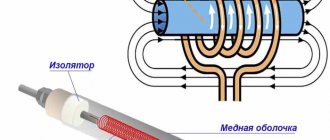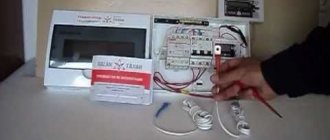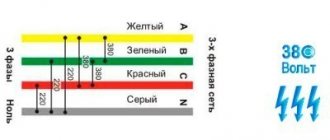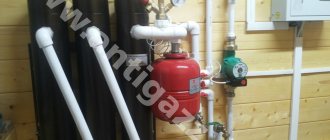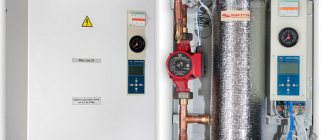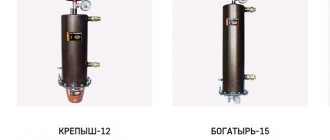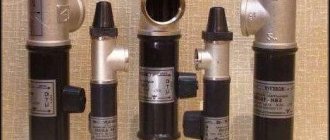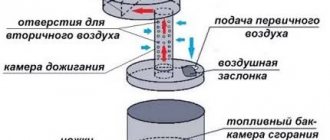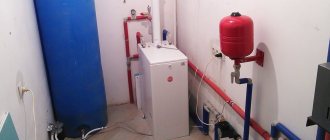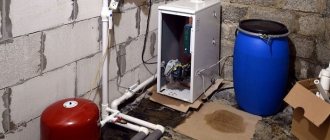*This material is subjective in nature and is not an advertisement and does not serve as a purchase guide. Before purchasing, consultation with a specialist is required. About the selection criteria.
Electric boilers are an excellent solution for those places where there is no gas supply. In addition, they have a lot of other positive qualities, for example, they do not require a separate room, they are much safer than gas ones, since in the event of an emergency they will simply turn off, and they have minimal heat loss. All this makes electric boilers an excellent option for the home. For those who decided to install one for themselves, the editors of BioKot have compiled a rating of the most economical electric boilers of 2022 for heating a private home.
Description and principle of operation of electric heating boilers
Gas boilers are popular due to the low cost of fuel, but it is not always possible to connect them due to the labor-intensive procedure and the need for coordination with government agencies. Energy sources for solid fuel units are even cheaper, but there are many more disadvantages - they pollute, require the removal of combustion products, fuel loading, and storage space.
The listed disadvantages are absent in electric boilers, which are sometimes the only option for heating if there is no possibility of supplying gas. Moreover, electrical devices are considered not only as additional or emergency sources, but also as the main devices for the preparation of coolant. With them you don’t have to worry about ignition and other inconvenient issues associated with fuel combustion.
The most economical electric boiler should be chosen from energy-saving induction and electrode models. But we must take into account that in any case, its operation will cost approximately 2.5 times more than gas units, at best 1.5 times. Economy is considered here for situations where there are no other alternatives to electricity or if this type of energy is cheap (there are alternative sources - solar collectors, etc.).
Installation Features
A wall-mounted electric boiler for low-power heating (for example, the “Mini” or “Economy” series) has a single-phase voltage of 220 V. For devices with a voltage of 380 V, a three-phase voltage is required.
For a regular household outlet, you can choose a low-power wall-mounted heater of the Economy or Mini class, which consumes no more than 3.5 kW. The power limit is calculated as follows: 16 A – current strength in home sockets. With an average voltage of 220 V, we obtain the maximum power - 3520 W (220x16).
Despite the fact that the technical characteristics of mini or economy boilers up to 12 kW allow connection to a single-phase power line, experts recommend connecting models from 6 kW to a 380 W power line.
Before installing a wall-mounted electric boiler, a cable with a recommended cross-section of 1 mm and a design load of 8 A is drawn from the switchboard. Floor-standing boilers are more productive; owners of houses with a large area should choose this type of boiler.
How electric boilers work, device
The general principle of operation of electric boilers for heating: the coolant (water) circulates using a pump along the circuit of the heating system, through the boiler (internal chamber, flask, coil) and is heated there by heating elements, heat exchangers with electrodes, and induction coils.
The main parts of the electric boiler: housing with heaters, circulation pump, power supply, expansion tank, control and safety system (pressure gauge, check valve and for releasing excess pressure).
Economical electric boilers are required in the following conditions:
- if it is not possible to use gas;
- a unit that is easier to maintain than fuel-powered devices is required;
- preference is given to a cleaner energy source;
- An additional heater is required in case the main device is turned off.
Infrared "warm floor"
Heating systems called “warm floors” are one of the types of infrared heating, widely used in the private sector.
Elements of heating systems of this type are produced, as a rule, in film form and can be installed under any type of synthetic and wooden coverings. In addition, they are easily installed under various tile coverings and composite-based materials.
Types of electric boilers for home heating
There are several types of electric boilers based on the principle of electricity use and operation. Traditional and familiar to everyone - heating elements. More innovative and energy-saving are induction (vortex) and ionic (electrode), they are more expensive, but the cost is paid off by extreme efficiency and efficiency, which weakly or does not decrease at all over time.
The efficiency of all electric boilers is the same - 94–99%, but some types are more efficient due to the design and method of operation. And also over time, due to scale, this characteristic decreases by 10–20% for heating element boilers, but this is not typical for induction and ionic products.
Types of electric boilers:
- with heating elements;
- ionic (heating by electrodes);
- induction (vortex).
Heating elements new electric boilers
Heating boilers with heating elements can only be classified as economical only conditionally: different models may have more efficient heating elements, programming capabilities, and power settings.
Inside the device there is a tubular electric heater - a copper or stainless steel tube (there may be sand or oil inside) with a filament (nichrome). The principle of operation is the same as that of a conventional boiler or air heater: the spiral inside the shell heats up and transfers heat through the tube in which it is enclosed to the water entering the chamber (flask) with the heating element.
When choosing electric heating for a home with a special emphasis on economy, units with heating elements should not be seriously considered. You can choose a high-quality device with more or less energy consumption, but it will still be more power-hungry than induction and ion boilers. On the other hand, the cost reduction can be compared to some extent, since a boiler with a heating element is cheap to maintain.
Advantages and disadvantages of heating elements electric boilers
Advantages of heating heaters with heating elements:
- cheap and convenient repair (the body is easily disassembled, parts are replaceable);
- advanced functionality: power adjustment, programmability, ability to connect a thermostat;
- usually produced in a monoblock compact case (there are convenient wall-mounted sizes) ready for operation, including a safety group, expansion tank, and pump. There is no need to separately purchase and install these elements; you only need to connect the device to the input and output of the heating system.
Minuses:
- the most uneconomical type of electric boilers, especially if two heating elements are used;
- Scale and plaque forms on the heating element, which requires periodic cleaning and replacement. A hard crust reduces efficiency by 10–20%. This statement is controversial, since the water of the heating system is not prone to intense scale formation, but it should not be ignored.
Induction boilers
Types of induction boilers for home heating (sometimes perceived as brand names):
- VIN - “vortex induction heaters”, more innovative with a ferromagnetic body. Smaller in size and 1.5–2 times more expensive than SAV, but more efficient;
- SAV - the principle is the same, but they are positioned as less advanced.
The second heating with vortex boilers is “inverter”. The product includes a current converter from direct to alternating current - an “inverter” (like welding machines).
Immediately after their appearance on the market, induction heaters for heating were positioned as the most advanced and efficient, but application experience showed more shortcomings than expected.
Operating principle of vortex SAV and VIN electric boilers
How does an induction SAV boiler work:
- A high-frequency alternating current (from 50 Hz) is supplied to a metal coil (inductor) - a rod (its role can be played by the coolant pipe itself) with turns of wire. A magnetic field is generated.
- The polarity and vector of the magnetic field change with high frequency.
- An object located close to the described phenomenon is penetrated by constantly changing fluxes of magnetic induction. Foucault eddy currents arise, turning electricity into heat, which heats the water.
The principle of heat transfer in induction boilers is non-contact - the object is heated by electromagnetic fields, and instantly. There is no need for physical contact with the inductor, which increases efficiency.
The electromagnetic principle is used in industry to melt metals. Even a small homemade induction device with a coil with a dozen turns and a few cm² in size is capable of heating metal to red in a few seconds, which illustrates the power and efficiency of a vortex boiler for heating.
Advantages of induction boilers for heating
Advantages of SAV boilers:
- heating is powerful, almost instantaneous;
- microvibrations repel dirt, so there is no scale or deposits on parts in contact with water, no cleaning required;
- economical, the highest efficiency among electric boilers.
Induction boilers are the best for preparing water as it flows through the apparatus, as they provide extremely fast heating. At the same time, heat loss is zero, which distinguishes VIN from heating elements units. Despite the disadvantages, if we consider purely the efficiency of using electricity, induction boilers are the most economical type of electric heaters.
Disadvantages of vortex boilers for heating, feasibility of use
Many sources list many advantages of VINs and SAVs, but in reality the picture is somewhat different; many shortcomings have been discovered:
- most standard sizes have significant dimensions;
- more expensive than heating elements and electrode units;
- heating is extremely powerful, so if the auto-shutdown system breaks down, there is an increased risk of explosion;
- the electromagnetic field is harmful, electrochemical processes provoke corrosion;
- complex repair. It would seem that the device is extremely simple - a coil and a housing - but usually the cylinder of SAV boilers is securely sealed, and it is extremely difficult to disassemble it. It contains electronic circuits of the control unit, which complicates repairs. The coil may burn out, and the cost of a new one is higher than, for example, a new heating element;
- if the SAV is not in a compact case, and the majority are, then a large control unit, a separate expansion tank, a pump, and a safety group will be required;
- in most cases, they are not equipped with a soft start - when turned on and even when simply switching modes, there is a sharp increase in the load on the network, which is fraught with voltage drops (flashing lights and similar effects).
Still, despite the listed disadvantages, a vortex energy-saving electric heating boiler should be considered as a heater for heating a house due to its high level of efficiency (30% more efficient than heating elements). Some of the listed disadvantages are relative, for example, there are small and compact sizes similar to those of products with heating elements. This is the only type of heater whose efficiency does not decrease over time.
Ion (electrode) boilers
Ionic (electrode) energy-saving heating boilers must be distinguished from induction units, despite the fact that they also use the properties of alternating current. The organization of energy use itself is different. The body of the device contains a sealed chamber with a coolant and electrodes located in it with a certain gap.
With a constant current, the cathode attracts water ions with a positive charge, and the anode attracts negative ones, but if you change the characteristic to a variable one (starting from 50 Hz), then a constant movement of these particles will occur. The medium has resistance, so the kinetic energy of moving ions (cations and anions) is transformed into thermal energy, and the electrolyte is heated.
In the ion boiler, a special electrolyte solution is heated, circulating in the pipes of the heating system; in certain cases it can be water. In fact, such a boiler is a simple heat exchanger.
Advantages of ion (electrode) boilers for heating systems
Advantages and features of ion boilers for heating:
- extremely compact: low-power models are only slightly larger than the diameter of the pipes. This is a small cylinder cut into the wiring. They do not require any space around them, so they can be installed literally anywhere;
- the cheapest - 4–9 thousand rubles. (A new heating element costs about 15-30 thousand), but if you have to buy an expansion tank, thermostat, safety valves, pump, then it’s another 10-12 thousand;
- scale does not form - this is prevented by electromagnetic processes;
- service life before the first breakdown is 12–15 years. According to this characteristic, electrode heaters are comparable to induction devices;
- maintainability. The design is simple and can be disassembled without much difficulty. Parts are replaceable and cheap;
- the safest: if induction or heating element boilers, if the automatic shutdown (protection against overheating and dry operation) fails, continue to heat up until an explosion or fire, then ionic boilers will simply stop working on their own without any intervention if the coolant leaks;
- no electromagnetic field.
Disadvantages of electrode heaters
Installation of the electrode device itself is simple, but it is somewhat complicated by the need to install a pump, safety group, and expander. There are also products with the last two elements on the body or in the form of a ready-to-use monoblock, but this arrangement is less common. In this aspect, heating element boilers have an advantage, since they are often produced in standard sizes with everything necessary in one housing.
Minuses:
- There are devices with a heat exchanger and an expansion tank on the body, but in most cases an additional purchase of these elements is required, as well as a pump and safety group;
- scale and plaque do not form, but electrical processes increase corrosion of the metal of the heating system circuit. In this aspect there is a similarity with SAV boilers;
- Pipe water can act as an electrolyte, but usually special solutions from the manufacturers of such boilers are always used. The mixture must be undistilled and unfiltered. Special substances are the most effective. Propylene glycol and ethylene glycol are used. You cannot use antifreeze, oil, or distilled water;
- requires replacement of the coolant every 3–4 years.
Electrode boilers consume 20–30% less electricity than heating element units, but they are slightly less energy efficient than induction models. That is, in the economy rating, if we take into account the convenience, low cost of the product and service, they are in the middle.
Method 7 - infrared heaters (the most economical)
Infrared heaters are considered the most economical of all types of electric heaters. They do not need heating elements and water pipes. Infrared heaters heat objects, not the room. Then the heated objects heat up the air. If an electric boiler can be compared to a kettle, then an infrared boiler can be compared to a microwave oven.
Infrared panels are especially popular. They are installed on the ceiling or walls of residential and industrial premises. Since the heating area is increased, the room becomes warmer faster than usual. Such a panel can be used as an independent heating source or as an addition to an existing system. An infrared heater goes well with electrode boilers. For example, an infrared heater can only be turned on in spring and autumn, when it is too early to turn on the main heating, or when it suddenly gets cold outside.
Pictured is a GROHE infrared panel, Germany
Date: September 25, 2022
Guidelines and what to consider when choosing an economical electric heating boiler
An economical electric boiler must have programmable operation, the ability to connect a rheostat for on/off. during periods of low tariffs or when a certain temperature is reached, as well as to regulate heating. At a minimum there should be at least a three-stage power switch.
The ideal option is if the device has smooth adjustment and factory economy modes. The product must be suitable for connection to room rheostats, which have many fine settings and respond to the air temperature in the room.
Single- and double-circuit electric boilers
If you need to provide hot water at the same time as heating, then choose double-circuit electric boilers. Moreover, the electricity consumption in such products is practically no different from single-circuit ones. DHW water is heated by washing the heat exchanger in the heating boiler circuit, without mixing with its coolant. Such heating does not require additional power, although for greater efficiency there are models with increased energy consumption.
The most economical
High financial costs for electricity during the heating season encourage consumers to choose energy-saving double-circuit boilers. The price segment of such models is quite high, but they are fully justified in terms of creating a comfortable temperature and providing hot water. We present an overview of the best energy-saving electric boilers.
ACV E-Tech S 240 28.8 kW
pros
- silent
- multifunctional
- economical
- reliable
Minuses
high price
From RUB 277,098
The household double-circuit electric boiler ACV E-Tech S 240 28.8 kW is recognized as the most economical. Electronic control helps reduce energy consumption to a minimum, heat the room and provide all residents with hot water. The boiler is equipped with all the necessary elements - pump, tank, boiler, pressure gauge. There is a function for connecting external control. Country of origin: Belgium.
Vaillant eloBLOCK VE 12 12 kW
pros
- high efficiency
- availability of summer mode
- modern attractive design
- simple controls
Minuses
To receive the 24 month warranty, installation must only be carried out by an authorized installer
From 35,000 ₽
If you can call an electric boiler smart, then it is Vaillant eloBLOCK VE 12 12 kW. Control is carried out with one button, everything else is done by the microprocessor, sensors and sensors. Thanks to the built-in summer and weather-dependent control programs, energy consumption is saved. The model received the largest number of positive reviews, in which users repeatedly noted the efficiency and reliability of the device.
We hope that the presented rating of electric boilers and a description of their advantages and disadvantages will help you choose an electric heating boiler for both a private home and an apartment.
Calculation of power for the area of the house
We present a simplified calculation of power, since this issue is a topic for a separate article. Approximate calculation usually always gives results as close as possible to real needs.
If the electric boiler performs an auxiliary heating function in addition to the main gas or other unit, or fireplace, then for 120–150 m² a power of 3–6 kW will be sufficient.
Comparative table of average statistical electricity consumption by electric boilers
| Electrode | heating elements new | ||||
| Boiler power | Heating area, m² | Consumption, kW/hour | Boiler power | Heating area, m² | Consumption kW/hour |
| 3 kV 1 phase | 50 | 0.5–0.6 | 3 kV 1 phase | 30 | 1.5–1.8 |
| 5 kV 1 phase | 80 | 0.9–1.2 | 5 kV 1 phase | 50 | 2.0–2.5 |
| 9 kV 3-phase | 120 | 1.8–2.3 | 9 kV 3-phase | 90 | 3.6–4.2 |
| 25 kV 3-phase | 350 | 4.5–5.5 | 25 kV 3-phase | 240 | 9.5–11.0 |
If an energy-saving boiler is the main source of heat, then it is necessary to carry out calculations taking into account heat losses, which for an average private home with two-brick masonry and 2.7 m ceilings in the climate of the Moscow region is 1 kW/hour. It is recommended to select power with a margin of 10–20%, and for heating element heaters - by 20–30%, since their efficiency decreases due to scale. For 80 m² you will need an electric boiler of 9.6–10 kW (8 kW + 20%).
For SAV boilers, a power of 2.5 kW is 2100 kcal/hour, which is enough to heat 25–30 m². The calculation is affected by the required temperature. If you need to maintain 15–20 degrees in a room of 120 m², then a 6 kW unit will suffice.
An economical ion-type electric heating boiler with a power of 3 kW is suitable for heating 50 m². The same product with a heating element will heat 30 m².
What requirements must you meet?
The unit must meet the following criteria:
- optimal power for heating the room;
- uninterrupted operation;
- maintaining optimal temperature;
- safety during operation.
It is believed that the power of an electric boiler is determined at the rate of 1 kW of electricity to heat 10 m2. It is worth adding another 20% to this value, since in severe frosts higher productivity is required. That is, an electric boiler for 100 square meters should have a power of 12 kW.
Next, you need to decide for what purpose the boiler is needed.
If for heating and water supply, then the value should be increased by another 20%.
NOTE! If you need to organize a heated floor, you can choose a boiler with a capacity of up to 15 kW.
For a house with an area of 100 square meters, the best option would be a compact-sized boiler that will not take up much space. At the same time, its power will be sufficient to heat all rooms, as well as to use additional functions.
What to choose: comparison of consumption, cost, ease of use
If we focus on ease of installation, ease of operation, and average price, then the first place in the ranking is occupied by boilers with heating elements. As a standard, they are carried out in a monoblock case that is completely ready for operation after installation - it already has a safety group, an expansion tank, a circulation pump and other elements. You just need to connect it to the input and output of the heating system. But they are in last place in terms of economy and cannot be called energy-saving.
If we consider the question of which electric boiler is the most economical and with the best energy saving, then we should consider induction and ion units.
Vortex heaters are in first place in terms of economy, but they have a number of disadvantages that slightly offset this advantage: price, difficulty in repair, large dimensions. These are the most expensive and inconvenient electric boilers considered: the cost of such a 25 kW product is 86 thousand rubles. (A new heating element for 24 kW can be bought for 46 thousand).
Below is a table comparing different types of electric boilers. But the data in it should not be unconditionally trusted - manufacturers are trying to show their products in a favorable light. For example, in other sources, ion boilers are shown to be much more economical and efficient than heating element boilers.
| heating elementnew | Electrode | Induction | |
| Efficiency | 98 % | 94 % | 99 % |
| Loss of power after 12 months of use | 20 % | 15 % | 0 % |
| Maximum pressure | 3 atm | 3 atm | 6 atm |
| Heating temperature | Up to 90 degrees | Up to 85 degrees | Up to 115 degrees |
| Life time | 3–7 years | 10–12 years | 30–60 years |
| Probability of failure within 12 months | 15–20 % | 15–35 % | 0 % |
Another disadvantage of SAV and VIN is the large dimensions of the housing itself and the individual elements that include the control cabinet. A product with a tubular electric heater contains everything you need in a compact case, and an ion boiler generally resembles a thick water pipe. The weight of a 25 kW induction boiler is 80 kg, a heating element of the same power is 40 kg.
Vortex boilers are increasingly being chosen for private homes. Although such devices are the most energy-saving, they are more often used in places where induction heating is indispensable - in industrial, production environments, and chemical plants.
Economics of VIN use
| The name of a room | Heated area/volume | VIN model | power, kWt | Cost kW/h, rub. | Monthly payment, rub./month. | Payment for the heating period, rub. |
| 1 room apartment | 50 m² | VIN-3 | 3 | 2.0 | 1227.6 | 9147.6 |
| House | 100 m² | VIN-7 | 7 | 2.2 | 2864.4 | 21334.4 |
| Garage box | 450 m³ | VIN-10 | 10 | 3.2 | 5952 | 45888 |
| Hangar | 1000 m³ | VIN-20 | 20 | 3.2 | 11904 | 91776 |
Ion (electrode) boilers are the best choice in the economy class in all respects, especially in terms of cost, if you need an energy-saving heater for heating a private home. Their economy and efficiency may be somewhat lower than that of induction and heating elements products, but this is compensated by ease of maintenance and small size. An important fact in favor of ion boilers is the price - these are the cheapest energy-saving heaters for heating (4-5 thousand rubles).
Ion boilers are a good option as an additional heating source. If you use them as main devices, you can embed several of these cylinders for greater efficiency.
The best known manufacturers and models: characteristics and prices
heating elements new
| Photo | Manufacturer and model | power, kWt | Mains voltage | Peculiarities | price, rub. |
| Elektromash EVPM-6 | 6 | single-phase/three-phase | One of the most inexpensive heating element electric boilers. For economical reasons, it has 3 power levels. | 1 900 | |
| ZOTA 9 Economy | 9 | three-phase | Well-known and reliable. Has 3 stages of power adjustment. It is possible to connect a room control panel with more precise adjustments. | 10 300 | |
| Protherm Skat 12KR 13 | 12 | three-phase | One of the best heating element energy-saving electric boilers for heating a private home. Equipped with 6-step power control and smart automation, the ability to connect a room thermostat and heated floors. The heat exchanger is additionally thermally insulated. There is auto-diagnosis, overheating protection, frost prevention mode, safety valve, air vent, pump blocking protection. | 34 000 |
Ionic
| Photo | Manufacturer and model | power, kWt | Mains voltage | Peculiarities | price, rub. |
| Galan OCHAG-5 | 5 | single-phase | One of the best energy-saving electric boilers for heating a private home. It has compact dimensions and functional, economical automation. It is possible to connect a room thermostat. | 4 100 | |
| Beryl-12 Ion | 12 | three-phase | Model from a famous Latvian manufacturer. The heating element has low inertia, and modern automation quickly and accurately assesses the degree of heating of the coolant and further prospects, which allows saving up to 20% of electricity. | 8 500 |
Induction
| Photo | Manufacturer and model | power, kWt | Mains voltage | Peculiarities | price, rub. |
| Alternative energy VIN 3 | 3 | single-phase | Today, it is the only worthy candidate among vortex induction electric boilers. The boiler is controlled through a control panel with many fine settings, including temperature. As a coolant, you can use not only water, but also antifreeze, oil, glycerin, and ethylene glycol-based coolants. | 34 000 |
Poll: what type of electric boilers did you choose?
